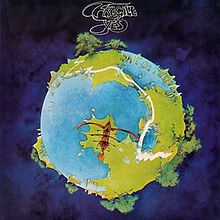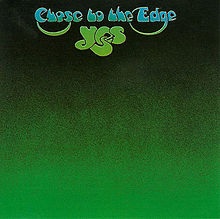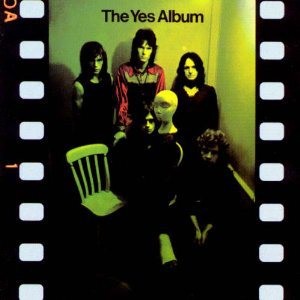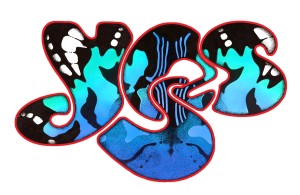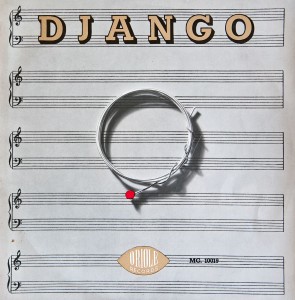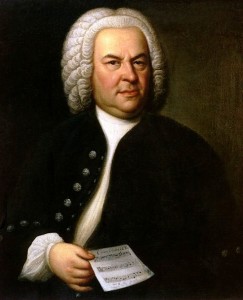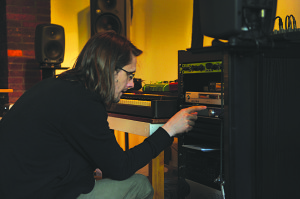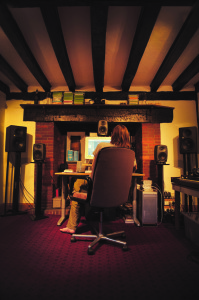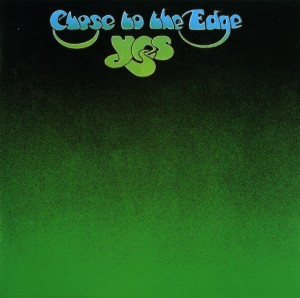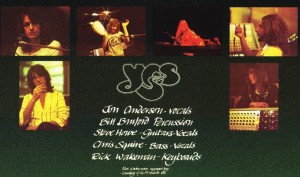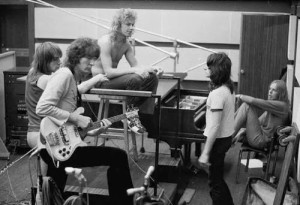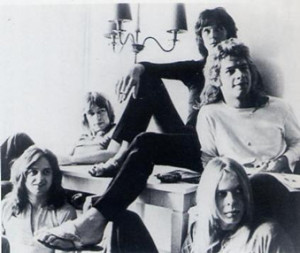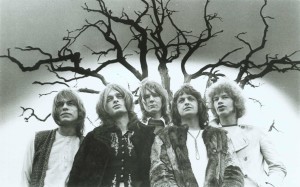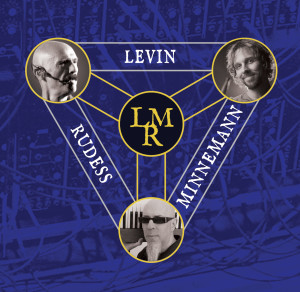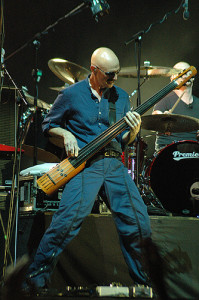“Yes likes challenges.” So says Yes guitarist Steve Howe, and the proof is in the output. The band has been out on the boards in the U.S. and Canada playing a set comprised of three full albums: The Yes Album, Close to the Edge, and Going for the One. On their upcoming summer tour in July and August, they’ll be doing two full albums: the first-ever full run-through of Fragile and Close to the Edge, in addition to an encore centered on the band’s greatest hits. Plus, an album with new lead singer Jon Davison, Heaven and Earth, is slated for a July release. And, of course, there are the sonically brilliant 5.1 mixes of Close to the Edge and The Yes Album on Blu-ray as masterminded by Steven Wilson — and more are on the way, with the band’s blessing. Howe, 67, and I ... Read More »]]>
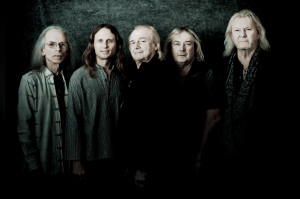
Going for the Five: Yes 2014, from left: Steve Howe, Jon Davison, Alan White, Geoff Downes, Chris Squire. Photo by Rob Shanahan.
“Yes likes challenges.” So says Yes guitarist Steve Howe, and the proof is in the output. The band has been out on the boards in the U.S. and Canada playing a set comprised of three full albums: The Yes Album, Close to the Edge, and Going for the One. On their upcoming summer tour in July and August, they’ll be doing two full albums: the first-ever full run-through of Fragile and Close to the Edge, in addition to an encore centered on the band’s greatest hits. Plus, an album with new lead singer Jon Davison, Heaven and Earth, is slated for a July release. And, of course, there are the sonically brilliant 5.1 mixes of Close to the Edge and The Yes Album on Blu-ray as masterminded by Steven Wilson — and more are on the way, with the band’s blessing. Howe, 67, and I talked about those 5.1 mixes, what we’ll hear on the new album, and what constitutes a musical legacy.
Mike Mettler: I’m so pleased to hear that you’re doing all of Fragile on the upcoming summer tour.
Steve Howe: Fragile is pretty accessible, and some of it we haven’t played for a helluva long time. It’s going to be a nice mix.
Mettler: Is there anything on it you’re just itching to play again?
Howe: Well, we all like “South Side of the Sky.” Things like “Five Percent For Nothing” are novelties because they’re so short. [“Five Percent” is 35 seconds long.] But we’ll dance through the entire album. It’s a challenge, and Yes likes challenges. Doing three albums was a big undertaking in itself, and we’ll get Fragile sorted. It’s really how close we get to the arrangements. We try to get as close as we can, but that makes different demands on different people, so I hope everybody is able to live up to it.
Mettler: I happen to think the surround-sound mix Steven Wilson did for Close to the Edge is one of the best ones I’ve ever heard. What did you think of it?
Howe: Yeah, it’s amazing. I was involved with some of the mixing, because he wanted some of my input. And since we were both in the U.K. at the same time, I got together with him to listen to some of it and talk about some of the details.
Mettler: What did you like the most about hearing this album in 5.1?
Howe: It’s not an easy question to answer. [laughs] He’s trying to get as close as he can to the original mix with what he was doing with the 5.1. At different times in my life, I’ve liked quadraphonic and 5.1, and so it’s really about having the hi-fi experience. And other times, it’s about having enough time for listening to things that way! But I admire him for doing it, and the label [Panegyric] for pushing to do it and giving us so many options in one release.
Mettler: Right — you have the needle drop, the updated mix, the original stereo, single edits, and the surround. The music on Edge is so enveloping to begin with that Steven’s 5.1 mix really puts us in the middle of what you guys were playing. Any moments you’d consider the most interesting?
Howe: You can hear the separation with the very fast organ playing at the beginning of “Close to the Edge.” It was overdubbed because Chris [Squire, bassist], Bill [Bruford, drummer], and I played together at the front end as a trio, and then we added Rick [Wakeman, keyboardist], who was playing remarkably fast — practically a double-speed version of the riff Chris and I played. But that kind of allows for the separation you can hear there.
Mettler: How involved were you with what Steven did for The Yes Album?
Howe: In a similar capacity. He wanted me to listen to what he did and then give my input. So I sat down with him and listened to it all. And before the Canadian tour started, I sat down with Steve for an afternoon and listened to [the next one Wilson is doing, which hasn’t been officially announced yet; sorry!—The SoundBard]. I did hear a few things, and they were able to take my comments and incorporate them as well as they could accommodate them. They’re very meticulous, in the way they want to match the original, or get as close to the original as humanly possible. Which in itself is a sort of paradox, because you have the original. [laughs] It’s also an unusual mix, but I’m very proud of Steve and that he’s going the whole distance. I’m just helping him where I can.
Mettler: He was very appreciative of you when he and I spoke about Edge in 5.1. He said having your input was invaluable to help keep things as faithful to the original as possible, and not, to use his words, “modernize it.” You were able to ground what he was doing.
Howe: That’s nice. On [the next one], there’s definitely a sonic improvement. There is a difference. It’s something that’s very, very hard to define — an openness to the higher registers of the music. It wasn’t easy doing all that with the technology of the time. Lining up every machine in the chain had to be perfect, and so did the phasing, the bias, the quality of the tape — it was all relying on so many things that are now blown away because everything is digital, you know. [laughs] It’s less reliant on lining up the accuracies of the tape, lining up engineers, lining up machines, the feed quality, and all the other things I mentioned. It was so boring then, and you just had to put up with it, but it was endless. The speed of the machines had to be so accurate to really be taken seriously, but nothing could ever be 100 percent perfect.
Mettler: There was a DVD-Audio 5.1 mix of Fragile in 2002. Do you think that’s an album Steven will get to revisit?
Howe: Maybe, yeah. That was one I mentioned to Steve. Although I appreciated what Tim [Weidner] did, I was unhappy that he included things that weren’t on the original record. Steven is only committed to having master parts on the recording — otherwise, it trivializes the idea. I was actually quite upset at what was on “Roundabout” — I mean, it’s fun that it’s different, but if it’s different, it’s wrong. I’m not too precious about it because not a lot of people heard it, but Steven’s remix will be thorough and consistent, and he will get around to Fragile. There are some issues with finding all of the masters, but we’ll get there.
Mettler: Is it open-ended that as many of the catalog masters you have in hand will get done in surround?
Howe: I don’t think we should say yea or nay yet, because there could be logistical things or even a question of taste. I mean, providing we don’t make a record sound worse [MM laughs], and we can make some of them sound even better. We’ve all got our favorite ones that we don’t like. I’m not going to say what it is, as there is an album like that which was disappointing sonically, and even the writing was a bit disappointing, and it’s in the ’70s —
Mettler: It wasn’t one that came out in 1978, was it?
Howe: [laughs] I’m not going to even go there! But there is one that’s like that sonically, structurally, and musically — everything about it. It’s not that it’s dreadful; it’s just that we didn’t quite get it right. I don’t know if a remix would make it right, but I really can’t say because I don’t think it could, because if you’re going to be true to the original, then you have to base it on the original.
Mettler: Well, what you could do is give people the original mix, just like you’ve done with Close to the Edge and The Yes Album — here’s the needle drop and the original stereo version, and now here’s the “updated” mix. Will we get to hear the new album, Heaven and Earth, in surround?
Howe: That’s a good idea. I mean, it’s funny that we’re doing music that’s 40 years old in 5.1, and yet we’ve just recorded Heaven and Earth and Fly From Here a few years ago [2011], and it might be more relevant to do 5.1 with those two releases. We’re a little backed up on time because of the touring, but maybe that could be a discussion later in the year so that we might have a 5.1 out by then. That’s a pretty cool idea.
Mettler: How would you characterize the sound of Heaven and Earth? You worked with Roy Thomas Baker as the producer.
Howe: I would say it sounds pretty different for us. It follows more the kind of material we’re playing with [current lead singer] Jon Davison and what he’s been writing, because Benoit David [vocalist on Fly From Here] didn’t really write with us. But this time, we are presenting a new writer alongside what Chris and Geoff [Downes, keyboardist] and I are writing. It’s the kind of an album that has a lot of freshness, and I think that’s quite a healthy thing. The cross-writing is quite interesting, as Jon has written with most of us. There’s quite a collaborative sense that Jon brought into play a lot. And his voice — we’ve gotten to see the effect of that element because of Roy Thomas Baker as we checked the mixes and got the whole feel. I’ve become quite happy with the album, and think it will be somewhat more of a surprise than Fly From Here.
Mettler: Do you remember the very first record you bought with your own money as a kid?
Howe: Yep! I do! There were two, if I’m allowed to mention two — there was Elvis Presley’s album, Rock ’n Roll [1956], with “Blue Suede Shoes” on it. I bought it from a friend who said, “I don’t really like this; do you want to buy it cheap?” And I said, “I’ll buy that!” And there was another friend of mine who had a 10-inch record with the picture of a guitar string on it, a Django Reinhardt record [Django, 1954], and I bought that too. Got them more or less at the same time, and they’re both records that have stayed with me my entire life. And I virtually couldn’t do without either of them. They’re the most remarkable records, because they went so deep to my personality as a guitarist and a musician.
Mettler: You can hear it as part of your DNA.
Howe: It is. Those records are very, very important. But then I bought Teensville by Chet Atkins [1960], and that brought some more into it. And as I’ve said before, Chet Atkins is the most central, singular great guitarists I’ve heard. I’m big on his early stuff, especially the fingerpicking.
Mettler: Earlier, you mentioned how important separation is in a surround mix. Your final thoughts on that idea?
Howe: Surround’s a funny animal. It’s really about separation. The separation is what makes for a good surround mix. There’s some great separation in these mixes, and I suppose that’s the main point of having these 5.1 mixes. Sometimes there’s an emphasis on reverb and an emphasis on “theater”— but 5.1 is also for theater, so in a way, we’re redesigning music around what’s made for a theater. So I say, great! Every time Bach is recorded from a cylinder to a 78 to a 33 to a 45 to a CD to a MiniDisc to an 8-track to a cassette [both laugh] — I mean, Bach’s music has gone through the same kind of transition that our music is going through. It’s keeping up with the times. It’s being reinterpreted by other people, redesigned through great recordings that can be rereleased over time.
And certainly J.S. Bach has one of the greatest, most fascinating histories of being reinterpreted by people like Glenn Gould and many, many others. Bach was one of the most amazing geniuses music has ever had because he had to do all that himself. He was thinking that music written for an organ wouldn’t necessarily stay on an organ — maybe there could be an arrangement for a choir! And that’s what he did himself. He was totally unprecious about the format. The format of the music isn’t important — what’s important is the music. And if it can transcend the performance, then I think you’ve got music that evidently will last.
]]>“On the surround mix, it sounds just like you’re in the room with Steve Howe while he’s playing those guitar harmonics.” Steven Wilson is describing the clarity of the gorgeous acoustic intro to “And You And I,” the second track on Yes’ groundbreaking 1972 LP, Close to the Edge. (Said intro is keenly accented by Rick Wakeman’s understated organ fills that lightly season the rear channels.) And I hate to sound like a broken, er, record, but the one true king of transformative surround-sound mixing (Porcupine Tree, King Crimson, Jethro Tull, XTC) has raised the all-channel bar yet again, for Wilson’s transcendent 192/24 5.1 CTTE mix is as pure and true as you’ll ever hear it on Panegyric’s Definitive Edition Blu-ray/CD combo package.
His wholly immersive, ear-boggling 5.1 mix achieves total mass attainment, highlighted by Wakeman’s uplifting, fully enveloping ... Read More »]]>
“On the surround mix, it sounds just like you’re in the room with Steve Howe while he’s playing those guitar harmonics.” Steven Wilson is describing the clarity of the gorgeous acoustic intro to “And You And I,” the second track on Yes’ groundbreaking 1972 LP, Close to the Edge. (Said intro is keenly accented by Rick Wakeman’s understated organ fills that lightly season the rear channels.) And I hate to sound like a broken, er, record, but the one true king of transformative surround-sound mixing (Porcupine Tree, King Crimson, Jethro Tull, XTC) has raised the all-channel bar yet again, for Wilson’s transcendent 192/24 5.1 CTTE mix is as pure and true as you’ll ever hear it on Panegyric’s Definitive Edition Blu-ray/CD combo package.
His wholly immersive, ear-boggling 5.1 mix achieves total mass attainment, highlighted by Wakeman’s uplifting, fully enveloping church organ sequence on the title track and Jon Anderson’s echo-laden vocal call-and-response word-association invocation in the rears during the back half of “Siberian Khatru.” Wilson also presided over a score of extras, including a UK vinyl transfer (a.k.a., a “needle drop”) and both the original 1972 and updated 2013 stereo mixes in 96/24. Here, we get up and we get down to digging even deeper about the surround mix’s minutiae, the title track’s aforementioned organ sequence, and the band’s response to Wilson taking this classic album to the absolute Edge.
Mike Mettler: So how does one go about making an admittedly “beautifully recorded and beautifully mixed” progressive masterpiece sound even better?
Steven Wilson: My goal is always the same: Be as faithful as you possibly can to the original mix, and don’t try to modernize it or improve it in any way — but allow for the fact that you’re going back to an earlier generation of tape. Remember that every kind of mix, every vinyl master, and every copy master is a further reduction in sound quality. But by using the original tape, I inherently knew I was going to get more tone out of the music and more out of the recording itself than anyone had been able to before.
Mettler: Producer Eddie Offord sure gave you one helluva template to work with.
Wilson: What I think a lot of people love about Eddie Offord’s original mix is the sense of energy and thrust the music has, which is partly the musicians and the way they play. But it’s also partly the fact he was mixing it to the red the whole time. He heavily saturated and compressed his mixes. He drove the tapes so hard that you get this sense of compression — not like mastering compression, but more like analog tape-mixing compression. I’ve always shied away from that because I like the dynamics of the music to breathe, and I don’t like that congested quality you get when you push things very hard.
So my new mix has taken a new tack, a more relaxed approach to the amount of compression. I tried to preserve more of the dynamics. There’s a lot more air, space, and depth that wasn’t present in the original mix.
Mettler: What kind of files were you working with?
Wilson: I had the 96/24 transfers that were done by Atlantic. They sent me these beautifully pristine, highly digitized files, with incredible high resolution. In theory, you’re not losing any of those lovely sounds on those tapes since they’ve been done at such hi res. And we had the luxury of keeping it that high all the way through the process and onto the Blu-ray release.
Mettler: Even with your extensive 5.1 mixing experience, this must have been a challenging project.
Wilson: It’s one of the most complex mixes I’ve ever done, yeah. I was trying to recreate two things: First, all of the performance aspects of the mix, and second, emulating the reverbs, delays, and echo effects. On “Close to the Edge,” especially in that middle section, there are sounds that are just drenched in old-fashioned plate reverb. And I’m very much a stickler for trying to make things have the same signature of the original effects units. Working in the digital domain, it’s very possible now to get very close to it, because we have fantastic emulations of those old analog effects units.
The thing about Yes and Eddie Offord is that the mixes really are performances. And what I mean by that is, very often when you do a remix, you set a level for the drums, you set a level for the bass, the guitar, the vocal, etc., and usually that remains fairly static throughout the mix. Not on the Yes mixes. Every little guitar phrase, every little vocal nuance, every little bass lick, and every little drum fill has potentially been pushed up in the mix manually. What that means is that you can’t just set your levels and let the mix run through. You have to literally analyze every few seconds, every few bars of music. I had to constantly compare back to the original mix: “Ah, they’ve lifted that little drum fill out!”, “Ah, they’ve lifted that guitar phrase out!”, “Ah, that vocal part is fading into reverb there.”
And I didn’t really do a lot of EQ, either. What’s on tape is pretty much recorded as they wanted it, so I didn’t mess with the tone of the instruments, the amount of bass, or the treble, or anything like that.
Mettler: Talk about what you had to do with Rick Wakeman’s organ sequence in the “I Get Up I Get Down” section of the title track.
Wilson: You mean the church organ? I didn’t know this when I was initially mixing it, but apparently they went and did that without having the context of the track. That is, they went to a church [St. Giles-without-Cripplegate in London], recorded the church organ in isolation, and then came back and spun it back into the multitrack. I didn’t know that at first, but it’s such a glorious, kind of overpowering sound. And you know what? That’s pretty much the way it is on the tape. All of the reverberation is the natural reverberation from the church where it was recorded, so, in actual fact, that was one of the simpler things to program back in.
Mettler: Was there any direct band input while you were working on your mixes?
Wilson: Sure. Steve [Howe] and Chris [Squire] heard it, but only when it was pretty much finished. Both of them really liked it. There wasn’t necessarily any sort of constructive criticism, but it was nice to have the seal of approval, let’s put it that way. Since then, Steve has been a lot more hands-on with the subsequent Yes stuff I’ve done. We get along quite well, and I appreciate his input.
Mettler: I’m glad you didn’t feel compelled to “update” the sound of the album in any way.
Wilson: Thanks. Why would you take Close to the Edge and add effects to it to make it sound, quote unquote, “more modern”? You wouldn’t. It has a slightly modern sound to it almost by default, because you have this extra clarity you don’t get from old analog mixes. Some people don’t like that. They prefer the kind of top-end rolloff you get with analog tape – and I totally understand that too, which is why we put both the old and new stereo mixes in these packages.
I’ve always been skeptical of artists who come around and say, “You know what, I’ve never liked that; let’s go ahead and change that.” Robert has done that a few times – Robert Fripp [of King Crimson]. And usually I talk him out of it, because I don’t think that’s the right idea. If something has been out for 30 or 40 years, people have grown to love it; they’ve grown up with it. It’s part of their life, part of their childhood, their youth, their old age, wherever they are. If you start going in and say, “I never liked that guitar part; let’s go ahead and move it,” or “let’s edit that, and let’s change this” – I steer away from all of that stuff, and I remain faithful to the original mix in both the good and perhaps not-so-precise aspects of it.
Mettler: Right, because if you start changing things and create a “completely remixed” record, the integrity of the whole project can come into question.
Wilson: Those kind of remixes are not really all that popular, are they? I’ve learned that that’s not the way to go. The way to go is to respect the decisions that were made and the sounds of the time, and not try to do this mixture of modern technology and old recordings. That’s just not the way to go. I think pretty much, without exception, people kind of prefer that sound anyway. The sound of ’60s and ’70s recordings is very much in vogue, and the sound of ’80s and 90s recordings is not, and people want things to sound a certain way. Even on my own last record [The Raven That Refused to Sing (and Other Stories)], I was looking for that kind of dryer, almost ’70s grain.
Mettler: I know there’s been some criticism that CTTE sounds “flat” because you were more interested in preserving the overall performance dynamics. My view is that people have to trade clarity for flatness – it’s more natural.
Wilson: Analog has this top-end rolloff, this inherent murkiness where all of the harmonies kind of get distorted, but in a pleasing way. In a sense, the music feels more like it’s glued together. Whereas when you work in the digital domain with pure beautiful transfers and you’re combining all of the instruments, you’re not going to get those kind of natural harmonic distortions. Some people use this word “clinical,” which I don’t agree with, but certainly there’s separation there that you simply won’t get in analog tapes. But there are extremes.
Mettler: Do you consider this one of your best 5.1 mixes to date?
Wilson: There are a lot of magical moments on there, yes. At the same time, I was absolutely terrified to do this mix. It’s almost like rewriting The Bible, isn’t it?
Mettler: Since it is such an iconic album, you must have felt some level of added pressure before you even cued up those tapes in your studio.
Wilson: I did. And the same way The Bible defines the way people live their lives, Close to the Edge has defined some people’s musical taste. For better or worse, you have to realize you could be messing with people’s minds, in a way. So that’s terrifying. But I enjoyed it, and I came away with more admiration for the record than I had to start with – which is no mean feat, because I thought it was terrific to start with.
Mettler: Close to the Edge is one of those benchmark records that I always come back to for a full-album listening experience.
Wilson: It’s a bona-fide A-level masterpiece. I think “masterpiece” is an overused word, but there are some records that deserve being called that, and this is one of them.
]]>Above, an exclusive YouTube clip of Levin Minnemann Rudess jamming on “Marcopolis”
BY MIKE METTLER
“I work hard on the music end of things, and record my bass parts as high quality as I can.” That, in a nutshell, is the mission statement for Tony Levin, noted bassmaster and Chapman Stick innovator known for his sharp-fingered low-end work with the likes of King Crimson and Peter Gabriel. At present, his holy mission specifically applies to the down-low flavors he’s concocted for Levin Minnemann Rudess (Lazy Bones Recordings), a 60-minute ride through quite progressive waters. His LMR namesake triomates are drummer Marco Minnemann (Steven Wilson, UKZ) and keyboardist extraordinaire Jordan Rudess (Dream Theater, Liquid Tension Experiment, Dixie Dregs). LMR is on CD, but you should only be interested in obtaining the Deluxe Edition, which contains a separate DVD with filmed interviews, improv sessions, ... Read More »]]>
Above, an exclusive YouTube clip of Levin Minnemann Rudess jamming on “Marcopolis”
BY MIKE METTLER
“I work hard on the music end of things, and record my bass parts as high quality as I can.” That, in a nutshell, is the mission statement for Tony Levin, noted bassmaster and Chapman Stick innovator known for his sharp-fingered low-end work with the likes of King Crimson and Peter Gabriel. At present, his holy mission specifically applies to the down-low flavors he’s concocted for Levin Minnemann Rudess (Lazy Bones Recordings), a 60-minute ride through quite progressive waters. His LMR namesake triomates are drummer Marco Minnemann (Steven Wilson, UKZ) and keyboardist extraordinaire Jordan Rudess (Dream Theater, Liquid Tension Experiment, Dixie Dregs). LMR is on CD, but you should only be interested in obtaining the Deluxe Edition, which contains a separate DVD with filmed interviews, improv sessions, outtakes, and — ahem, fellow audiophiles — 24-bit wav files of the full album.
If you check out The S&V Interview Blog at soundandvision.com, you’ll find us discussing the concepts of composition vs. improv and the trio’s overall sonic goals for their heady collaboration, plus LMR producer Scott Schorr theorizing about the possibility of a 5.1 mix. That was Part I. Here on soundbard.com, you get the exclusive Part II, wherein Tony discusses working with Steven Wilson and Peter Gabriel, and Scott delves deeper into his own 5.1 preferences, including his favorite Steven Wilson surround mix(es).
And yes, all ye faithful Crim lovers, Tony also shared with me his initial impressions of what to expect from King Crimson’s eighth incarnation. “It’s early in the planning stage,” he reveals. “We know the players, and we’re comparing schedules to see when we can get together to rehearse. Likely it’ll start next September [2014], and likely will look back at the King Crimson repertoire for material. However, I expect plenty of surprises along the way — that’s the way it usually is with Crimson.”
To mutate a few lines from Crimson’s bleat-tastic “Elephant Talk,” what follows is more than just small talk, babble, expugnations, and/or idle chit-chat.
MIKE METTLER: Steven Wilson did many fantastic mixes of King Crimson material in 5.1. Would you like to work with him on other projects?
TONY LEVIN: I’ve played on some of Steven’s solo projects, and yes, I do look forward to working with him again. On our [2010] Soup album, we the Stick Men brought Steven in to mix our version of Stravinsky’s “Firebird Suite” (a particularly complex piece) and were very happy with the results. [I can confirm that Wilson did an amazing job mixing all four parts of the “Suite,” which appear as Tracks 9-12 on Soup; it’s challenging listening, to be sure, but you’ll want to conduct along with each movement, right on through to the ultimately elegiac nature of Part 4 —The SoundBard]
METTLER: You got to attend Steven’s solo show at the Royal Albert Hall in London on October 20. How was it? He and his band must have sounded amazing in that storied venue.
LEVIN: It was excellent. Sound was great, as you’d expect, and it was 3 hours of performance, with only a 20-minute intermission (due, he said, to the venue’s rules). Nick Beggs was super on bass, and he played Stick quite a bit — quite a treat for me to see a Stick player in the rock context. I don’t get to see that often, and I really enjoy it. I even think I saw him thumbslapping on the Stick (though I was far away from the stage, it looked like he was doing that) and I’m going to explore that technique, which I hadn’t heard of before.
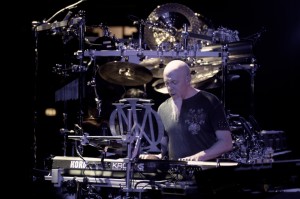
Rudess Behavior: Was there a conscious effort to compose music for LMR, or improvise it? Levin: “Jordan and I did quite a bit of jamming together, ready for Marco to play to, but we had so much good quality material written that there just wasn’t need to further develop the improv material.”
METTLER: You’re been on the road with Peter Gabriel for over a year, and counting. I saw the So — Back to Front tour in Philadelphia last year [on September 21, 2012], and was consistently impressed by the live sound quality. And I also appreciate being able to have an official soundboard version of the show I attended — a soundboard for The SoundBard, as it were. Why does So continue to have such an impact?
LEVIN: We’ve been having a great time out here on the road, doing the So music and tour quite close to the way we did it back in 1987, and with the same band. I can’t say there are favorite songs in the show for me — I’m somewhat equally happy during the whole show. It’s great being part of a band, and a production, that’s really giving the audience what they want. Peter’s ideas about show production are pretty groundbreaking, and the way the lights and crew choreography add to the music in the show is quite special. I can’t resist photographing quite a bit of the show, even while I’m playing in it, so my online diary has become a nice way to get the feel of the tour — both for those of us on it, and for the fans who came to shows and like seeing the “band’s-eye” photos.
METTLER: A number of Peter Gabriel’s tours are available on Blu-ray [New Blood: Live in London, Secret World Live, and Live in Athens 1987]. Do you like the Blu-ray format?
LEVIN: I’m not an expert at formats, but I can say that we just recorded this show in a very hi-def format (4K Ultra HD) on October 21 and 22 [at the O2 Arena in London]. It’ll be great to have a concert film made to commemorate this tour. I can’t tell you when the show video will be out, or even in what manner and format. I hope to find out myself before long! [Keep soundbard.com bookmarked for updates —The SoundBard]
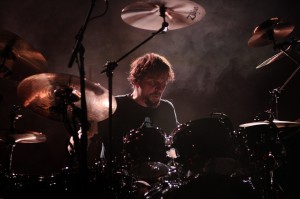
Minnemann of Action: The drummer gave the bassman excellent aural blueprints to work with for LMR, says Levin: “As for the bass parts I played, Marco sent me tracks where he had played not just drums, but guitar and bass, too — the bass to give me a sense of where he was going. In some cases, I played a different part altogether; in others, I played somewhat what he had, keeping the essence of it, but giving my own flavor to the part — and in a couple of cases, I played exactly what he’d suggested for the bass part. ”
METTLER: Ok, Scott, your turn. Tell me what your favorite surround mixes are, and why.
SCOTT SCHORR: My favorite 5.1 mixes are anything that Steven Wilson touches. I see Steven as the modern-day Phil Spector meets John Lennon. One thing I love about his 5.1 mixes is they always seem to stay as close as possible to the original mixes. However, in 5.1, he allows everything to breathe. Just listen to “Elephant Talk” [from King Crimson’s 1981 album, Discipline] on a great surround sound system. Tony Levin’s stick seems to bounce from one speaker to the other. Bill Bruford’s drum sound is incredible, and his snare is tighter and brighter than it usually is. Another Crimson album Wilson remixed, [1970’s] Lizard, is incredibly experimental, and would scare the average listener. But for the hardcore fan, the separation of the instruments in 5.1 is why the medium is growing as fast as it is.
In the original stereo mixes of Lizard, there’s so much stuff going on that it’s sometimes hard to decipher all the parts in the original stereo mix versus 5.1. And to consider that Robert Fripp was occasionally standing over Steven while he was mixing the Crimson catalog in 5.1? Now that is pressure!
I also know this is sacrilegious in some circles, but I’m a big fan of the ’70s classic records when they’re converted from analog to digital for 5.1. It just seems to “crispen” everything up and add clarity to all the instruments — without sacrificing all the warmness. And I’m super-anxious to hear Steven’s 5.1 remix of Yes’ Close to the Edge, one of my all-time favorite records. [Me too! —The SoundBard]
METTLER: Back to you Tony, with a quick barrage of Qs to wrap this up. What was the first record you bought with your own money? Does it still resonate with you today? Do you still have a copy of it? Do you still like the vinyl format?
LEVIN: I’m afraid I don’t remember that. (It was a long time ago!!) I was a classical music fan from a young age and listened to a lot of material, probably mostly on the radio. I did like the vinyl format, and somewhere I have my records from my teens — but like with the CDs I’ve collected, I don’t have much time to listen anymore. Happily and luckily, I’m too busy making new music most days.
Above, an exclusive YouTube clip of Levin Minnemann Rudess tackling the mysteries of “Scrod”
]]>